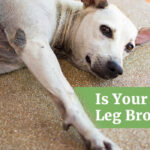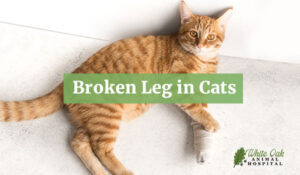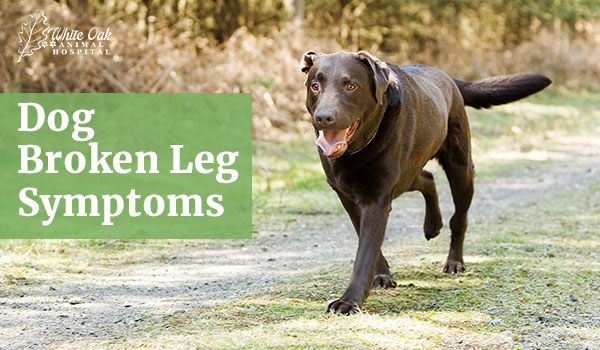
Recognizing dog broken leg symptoms early can make all the difference. What looks like a mild injury may be a fracture. Dogs often hide pain; without obvious signs like swelling or a crooked limb, it’s easy to misjudge the seriousness. Some owners wait too long before seeking help.
Your dog starts limping. It hesitates to climb stairs or avoids putting weight on one leg. It yelps when touched. You figure it’s a strain. Maybe it will pass in a day or two. This is where many people go wrong.
Delaying treatment causes the injury to get worse. A small break can shift. Pain increases. Scar tissue builds. Bones may heal in the wrong position. The longer it sits untreated, the harder it is to correct. Recovery can become more prolonged, more expensive, and more painful.
In this article, we’ll break down five reasons why waiting is risky. We’ll explain how to spot typical dog broken leg symptoms, what happens when they’re ignored, and how integrative care approaches—used at White Oak Animal Hospital—can improve your dog’s outcome in ways standard care alone may not.
Dog Broken Leg Symptoms That Signal Immediate Risk
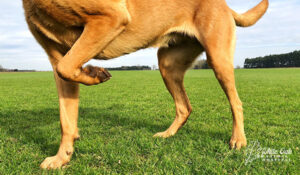 The first signs of a problem are often minor. A limp. A paw held up. Your dog may avoid jumping or showing stiffness after resting. In some cases, you’ll see swelling or bruising. It might yelp when the leg is touched. You might see licking at one spot or notice your dog acting withdrawn.
The first signs of a problem are often minor. A limp. A paw held up. Your dog may avoid jumping or showing stiffness after resting. In some cases, you’ll see swelling or bruising. It might yelp when the leg is touched. You might see licking at one spot or notice your dog acting withdrawn.
These dog broken leg symptoms should not be dismissed. Even when a dog can still walk, it may be masking a break. Dogs often adjust their movement to avoid pain. They may appear stable initially, only to worsen quickly as the injury worsens. A fracture that is not stabilized early can shift out of place. The bone may press on nearby nerves or restrict blood flow. Both create problems that are harder to fix later.
It’s common to confuse dog-broken leg symptoms with signs of arthritis or a pulled muscle. But if the limp doesn’t improve in 24 hours, or your dog seems more sensitive or irritable, it’s time to take it seriously. What starts small may become a more extended, more painful problem.
The earlier we assess the damage, the more treatment options we have. Our job is to determine what’s going on. If it’s a soft tissue strain, we can treat that conservatively. Stabilizing it early protects the bone and surrounding tissue if it’s a break. Every hour that passes increases the risk of complications.
Dogs don’t always cry or stop moving when a leg is fractured. That’s why it’s essential to know the subtle signs. Recording short videos of your dog walking or showing discomfort can help us make a faster diagnosis. If you see these signs, take them seriously.
Dog Broken Leg Symptoms That Get Worse Without Treatment
 Waiting to see if an injury improves can backfire. Dog broken leg symptoms often become more severe over time. What begins as a limp may become a complete refusal to use the leg. Pain increases. Inflammation builds. Your dog may stop eating, sleep less, or appear restless. These are all signs the condition is getting worse.
Waiting to see if an injury improves can backfire. Dog broken leg symptoms often become more severe over time. What begins as a limp may become a complete refusal to use the leg. Pain increases. Inflammation builds. Your dog may stop eating, sleep less, or appear restless. These are all signs the condition is getting worse.
One of the biggest concerns with untreated fractures is that the bone starts to heal the wrong way. This is called malunion. Once the bone sets in the wrong position, it may need surgical correction. That adds cost, stress, and recovery time. In other cases, soft tissues near the break become damaged. Muscles tighten. Ligaments strain. Healing slows down, and scar tissue can form around the injury.
Dog broken leg symptoms are also linked to behavior changes. Dogs in pain often become anxious or withdrawn. They may hide or become unusually reactive. These changes are not always apparent initially, but they are worth tracking.
There is also a real risk of infection if a break is left uncleaned or becomes an open wound. Even minor wounds near a break can introduce bacteria. The deeper the infection goes, the more aggressive the treatment needs to be.
Sometimes, dog broken leg symptoms temporarily improve and then return worse. That can give a false sense of recovery. The dog compensates, shifts its weight, and masks the injury. But the underlying issue continues to worsen. By the time it becomes apparent, more damage has already been done.
There are also some blood markers that may help detect trauma-related inflammation. These tools are not yet widely used but may one day give earlier clues to internal damage.
In short, symptoms appear when a dog has a broken leg, and waiting increases the risk of permanent issues. Early action protects your dog’s comfort, mobility, and long-term health.
What Integrative Vets Do Differently with Dog Broken Leg Symptoms
White Oak Animal Hospital uses a combined approach to treat dog broken leg symptoms. Our method blends modern diagnostics with Eastern techniques that support healing from multiple angles. This approach gives us more tools and allows for more customized care.
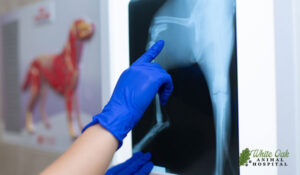 We start with imaging. X-rays help us understand the type and location of the fracture. We also check for soft tissue injuries or nerve involvement through physical and neurological exams. This gives us a clear picture of what needs to be addressed.
We start with imaging. X-rays help us understand the type and location of the fracture. We also check for soft tissue injuries or nerve involvement through physical and neurological exams. This gives us a clear picture of what needs to be addressed.
Once we know what we’re dealing with, we add acupuncture. Acupuncture helps calm pain signals and reduce inflammation. It also improves circulation around the injury, which supports tissue repair. Many dogs relax during treatments. Acupuncture becomes part of the healing process, not just pain control.
Herbal medicine is another option we often include. Formulas like Bone Stasis or Du Huo Ji Sheng Tang can support the body’s response to trauma. These herbs help reduce swelling and support bone healing. They don’t replace medical care. They work alongside it.
We also use food therapy. Nutrition matters during recovery. We may recommend diet changes that support tissue strength, reduce inflammation, and boost energy. This is based on your dog’s age, breed, condition, and constitution. Kidney treats in particular provide excellent support for broken bones.
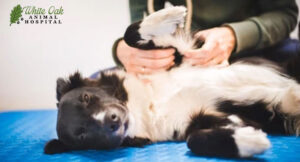 Dog broken leg symptoms require thoughtful care. No two dogs heal the same way. Some need more support in the beginning. Others need long-term follow-up. We build protocols around each case. That might include splints, acupuncture, rehab, or customized herbal support. It’s all about finding what works.
Dog broken leg symptoms require thoughtful care. No two dogs heal the same way. Some need more support in the beginning. Others need long-term follow-up. We build protocols around each case. That might include splints, acupuncture, rehab, or customized herbal support. It’s all about finding what works.
We also offer telemedicine consultations. These can be helpful in reviewing early symptoms or planning the next steps after an injury. If your dog is nervous, difficult to transport, or in pain, a video consult can help us guide you.
How we treat dog broken leg symptoms reflects our belief in treating the whole dog, not just the broken bone. It’s about restoring movement, managing pain, and supporting real recovery.
Dog broken leg symptoms don’t always show up as emergencies. Sometimes, the signs are subtle. A slight limp. A quiet wince. A dog that just isn’t acting right. These changes matter. They are often the first clue that something more serious is going on.
When treatment is delayed, problems build. Bones may heal out of place. Soft tissues can tear or become inflamed. Pain becomes more complicated to manage. What could have been a simple fix turned into a long recovery. Your dog deserves better.
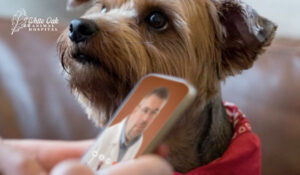 At White Oak Animal Hospital, we treat injuries with a broader lens. Our care combines imaging, acupuncture, herbal support, and personalized recovery plans. We focus on comfort and function, not just stabilizing the break. Our experience spans over 28 years, and our approach reflects what we’ve learned.
At White Oak Animal Hospital, we treat injuries with a broader lens. Our care combines imaging, acupuncture, herbal support, and personalized recovery plans. We focus on comfort and function, not just stabilizing the break. Our experience spans over 28 years, and our approach reflects what we’ve learned.
We also provide telemedicine consultations. If you’re unsure whether symptoms are severe, we can help you figure it out before committing to a visit. We know timing matters, and we want to make it easier to act quickly.
Dog broken leg symptoms need attention. They don’t always mean surgery, but they do require a plan. If your dog is limping, favoring one leg, or acting off, call us. We can help you figure out what’s going on and what to do next.
Even minor symptoms can point to a big problem. Getting ahead of it is the best way to protect your dog’s health, comfort, and ability to move freely again.
Frequently Asked Questions
Can a dog walk on a broken leg?
Yes, some dogs can still walk on a fractured leg. This happens more often with minor or hairline fractures. It does not mean the injury is minor. Dogs can tolerate a surprising amount of pain and will continue moving if they need to. That is why dog broken leg symptoms must be taken seriously even if your dog is still mobile.
How do I know if it’s a break or a sprain?
You can’t tell for sure without imaging. Both can cause limping, swelling, or sensitivity to touch. A break may also include stiffness, yelping, or changes in posture. But many signs overlap. We use exams and imaging to confirm what’s going on. Don’t guess based on symptoms alone.
What should I do while waiting for the vet?
Keep your dog calm and restrict movement. Use a crate or a quiet space to avoid stress. Don’t try to move or stretch the leg. Avoid giving any human medications unless directed by a vet. These can interfere with diagnosis or cause side effects.
Do integrative vets treat fractures differently?
Yes. Our approach combines Western stabilization with acupuncture, herbal formulas, and nutritional support. This allows us to control pain, reduce inflammation, and support healing. We don’t treat just the bone. We support the whole body.
What if my dog’s leg seems better after a few days?
This can be misleading. Dog broken leg symptoms may fade as the dog adapts or compensates. But the damage may still be there. Without imaging, we can’t be sure the leg is healing properly. If symptoms return or change, follow up with a vet.
Related Posts
-
How to Know if Your Dog's Leg is Broken: 5 Clear Signs of Injury
Understanding how to know if your dog's leg is broken is crucial for ensuring your…
-
Learn How To Alleviate Dog Leg Pain Naturally
Dog arthritis is the top cause of chronic dog leg pain. Arthritis affects approximately 20%…
-
Traditional Dog UTI Treatment Options
Finding an effective dog UTI (urinary tract infection) treatment isn't hard. In fact, a UTI…
-
Effective Relief For Allergic Dog Symptoms
An allergic dog is easy to spot! Sure, all dogs itch and scratch, but you…

